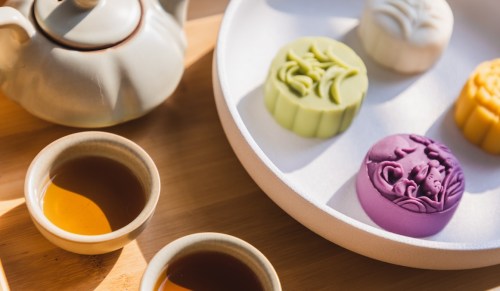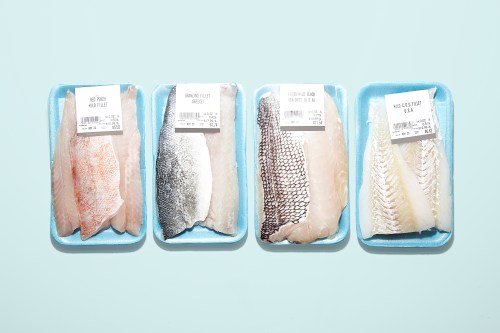Across many Asian cultures (spanning China, Taiwan, Korea, Vietnam, and beyond), September’s full moon marks one of the most significant days of the year: the Mid-Autumn Festival.
“It’s right before the traditional harvesting season and the date coincides with a full moon, making it an ideal time for gathering with loved ones to give thanks, eat good food, and admire the moon together,” says Cindy Chou, RDN, a dietitian, chef, and the founder of The Sound of Cooking.
One such delicacy that’s integral to the festivities is the mooncake, which varies in style across different countries and regions. For instance, Chou says that Cantonese-style mooncakes often use a pastry crust and red bean paste for a sweet treat. In Taiwan (from which Chou’s family hails), mooncake crusts are light, flaky, and akin to puff pastries.
But why does the moon—both in the sky and on your plate—hold so much significance? “In Chinese and Taiwanese cultures, circular objects like a full moon and round mooncakes symbolize unity,” Chou explains. “Because of this, gifting or sharing mooncakes with friends and relatives signifies togetherness.”
Ahead, Chou shares her own snow skin mooncake recipe, which she says is a modern take on the traditional mooncake. The perks? “They are simpler to make at home, making it easy to customize and get creative with the outer designs and fillings,” she shares. While it’s a labor of love, it’s loaded with palate-pleasing flavors plus a decent dose of protein and fiber-rich veggies, to boot.
Benefits of this snow skin mooncake recipe
This no-bake mooncake recipe for the Mid-Autumn Festival was designed to be simple even for first-timers, as well as nutritious and customizable. If you follow Chou’s recipe to a T, you can anticipate a few nutrient-specific benefits.
Her recipe includes mung beans, a legume that packs both protein and fiber (7 grams and 7.6 grams, respectively, per half cup). “Studies have shown that a higher intake of legumes may be associated with a lower risk of heart disease,” Chou explains. “Consuming legumes like mung beans may also have the potential to lower LDL cholesterol, though more research is needed.” The salted egg yolk also contributes to the total protein count. “[Each] not only adds 2.8 grams of protein to each mooncake, but also a layer of savory flavor that complements the subtle sweetness so well,” she continues.
Last but not least, if you’re fortunate enough to be able to make and/or share these high-protein snow skin mooncakes with family or other people you love, you’ll be primed to enjoy additional perks such as:
- Less stress
- Higher self-esteem
- Stronger relationships
P.S. If you want to put your own spin on this recipe, Chou invites you to switch things up to your liking. “You can experiment with different fillings at home, such as a red bean paste filling,” she shares. “Try using a larger mold to make mooncakes with extra filling for even more flavor and added fiber.”
High-protein snow skin mooncake recipe
Yields 12 mooncakes (1 3/4 oz each)
Ingredients
For the filling:
3 ounces skinless dried mung beans, soaked in water for 6 hours or overnight2/3 cup water2 Tbsp canola oil35 grams sugar1/8 teaspoon kosher salt12 salted duck egg yolks, defrosted
For the skin/wrapper:
50 grams sweet rice flour, divided35 grams rice flour25 grams corn starch30 grams sugar135 grams whole milk15 grams sweetened condensed milk20 grams canola oil1/2 teaspoon matcha powder, optional
- 1.Make the filling and toast sweet rice flour: Drain and rinse the soaked mung beans, then transfer to a small baking dish and add the water.
- 2.To steam, place a metal steam rack inside a 14-inch or larger wok. Add water to the wok until it’s just below the top of the steam rack. Then, place the baking dish with the mung beans and water on top of the steam rack. Cover the wok with a domed lid and turn the heat on high until the water boils, then reduce the heat to medium-low. Steam for 20 minutes and turn off the heat. Alternatively, the mung beans can be simmered in a small 1.5-quart saucepan, covered.
- 3.While the mung beans steam, toast 15 grams of sweet rice flour in a small skillet over low heat, stirring occasionally, for about 2 minutes. Set aside for dusting the mooncakes.
- 4.Transfer the steamed mung beans to a medium (11-inch) non-stick skillet. Cook over medium heat to dry, stirring constantly with a silicone spatula, about 15 minutes. The filling will slowly become smoother and paste-like. At this point, turn the heat down to medium-low and continue to stir until the paste becomes dough-like and no longer sticks to your spatula, about 20 more minutes. Transfer to a rectangular baking dish, distribute evenly with a spatula, and score the filling into 12 square portions. Cover and allow to cool for 10 minutes.
- 5.Prepare the snow skin wrapper dough while the filling cools.
- 6.Once the filling is cooled to the touch, weigh each portion on a kitchen scale. Each one should be 15 grams. Roll each piece into a ball, then set aside, and cover.
- 7.Make the snow skin dough: In a microwave-safe medium mixing bowl, whisk the remaining 35 grams of sweet rice flour, rice flour, corn starch, and sugar until thoroughly combined.
- 8.Add the milk, condensed milk, and canola oil to the bowl of dry ingredients and whisk until the ingredients are well combined.
- 9.Cover the bowl with a microwave-safe plate and microwave for about 2 minutes or until the dough becomes mostly opaque and has a firm gel texture (keep in mind the time may vary by microwave). Stir the dough with a spatula to allow for quicker cooling.
- 10.Once cooled to the touch, knead the dough until it is smooth. Using the palm of your hands, roll it out into a log shape, then cut it into 12 portions. Weigh each portion on a kitchen scale. Each one should be 20 grams. Roll each piece into a ball, then set it aside, and cover with plastic wrap.
- 11.Add color to the skin (optional): Sprinkle each piece of dough with matcha powder, fold the dough, knead, and repeat until the color is distributed evenly.
Assemble the mooncakes
- 1.Start by flattening a portion of the mung bean paste filling with the palm of your hand. Place one salted duck egg yolk in the center and wrap the paste around the yolk. Gently roll it in between your palms to form a ball. Repeat this step for 11 more portions.
- 2.Place a portion of the snow skin dough on a flat surface and flatten it with the palm of your hand. Roll the dough out into 3-inch diameter wrappers, with the edges slightly thinner than the center.
- 3.Place the filling in the center of the wrapper and gently fold the outer edges of the wrapper over the ball. Gently push the sides so the wrapper sticks to the filling without air pockets, then pinch the ends of the wrapper together to seal. Roll the mooncake into a ball.
- 4.Lightly dust the ball with the toasted sweet rice flour and place it into a 25-gram (smaller-sized) mooncake mold, with the smooth side facing the stamp plate. Place the mold, opening face down, on a clean flat surface and gently press the spring-loaded handle down. Lift the mold while pushing the handle down to release the mooncake. Keep it covered in a container.
- 5.Repeat assembly steps above for the remaining mooncakes. If needed, clean the molds in between use with a toothpick.
- 6.Serve immediately with your favorite tea or share them with loved ones as a gift.
If you have leftovers, Chou says the assembled mooncakes will keep for two to three days covered and stored in the fridge. “The wrapper should remain soft but will lose some of its elasticity,” she notes. Meanwhile, if you have extra mung bean paste filling, it’ll keep for up to three months frozen in an air-tight container.
Sign Up for Our Daily Newsletter
Get all the latest in wellness, trends, food, fitness, beauty, and more delivered right to your inbox.
Got it, you've been added to our email list.











